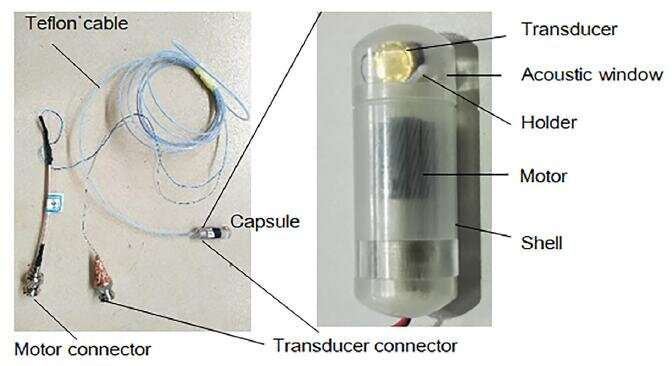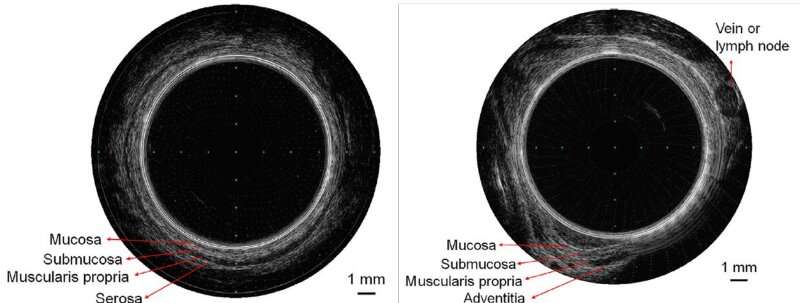
A research team led by Prof. Qiu Weibao from the Shenzhen Institutes of Advanced Technology (SIAT) of the Chinese Academy of Sciences has introduced a novel micro-ultrasound capsule endoscopy (μUSCE). It’s a capsule equipped with micro-ultrasound (μUS) transducers, capable of imaging below the gastrointestinal wall surface, thereby offering a complementary sensing technique to optical imaging capsule endoscopy.
The μUSCE device is consists of a micromotor, a transducer holder and an ultrasound transducer, encased in a biocompatible shell with an acoustically transparent window.
The USCE shell of diameter 10 mm and length 30 mm is made from biocompatible poly methyl methacrylate (PMMA).
The μUS transducer is fabricated from a piezocrystal LiNbO3 to operate at a resonant frequency of 30 MHz, with a press-focused focal distance of 8 mm and the diameter of 3 mm. It is placed in a PMMA holder that aligns it with both the central longitudinal axis of the capsule and the acoustic window.
The USCE is connected to external instrumentation that drives the motor and controls ultrasound transduction via a Teflon tube of outer diameter 1.7 mm and inner diameter 1.1 mm. All components and bonding were achieved with medical grade epoxy.
An imaging platform was developed specifically for the evaluation of the proposed μUSCE device. The control of the motor back and forth rotation was realized through two analogue switch channels to control the supply of positive and negative power inputs.

To demonstrate the effectiveness of the device, in vivo studies were performed in the female Landrace pigs, because they have gastrointestinal tract anatomic and physiologic similarities with humans.
B-scan data of the small intestine and the esophagus was recorded during the in vivo experiments. It demonstrated that micro-ultrasound with a mechanical rotation scheme is feasible for assessing the gastrointestinal tract by providing high-resolution ultrasound images.
The proposed scheme in this study paves the way for the implementation of capsule ultrasound devices, and demonstrates the possibility of this capsule by the high-resolution, cross-sectional in vivo imaging.
“This video capsule endoscopes conform to commercial dimensions and are acceptable for clinical use. But the length and shell of the capsule require more engineering work and careful design for further development of ultrasound capsule endoscopes,” said Dr. Huang Yaocai from SIAT.
Source: Read Full Article
